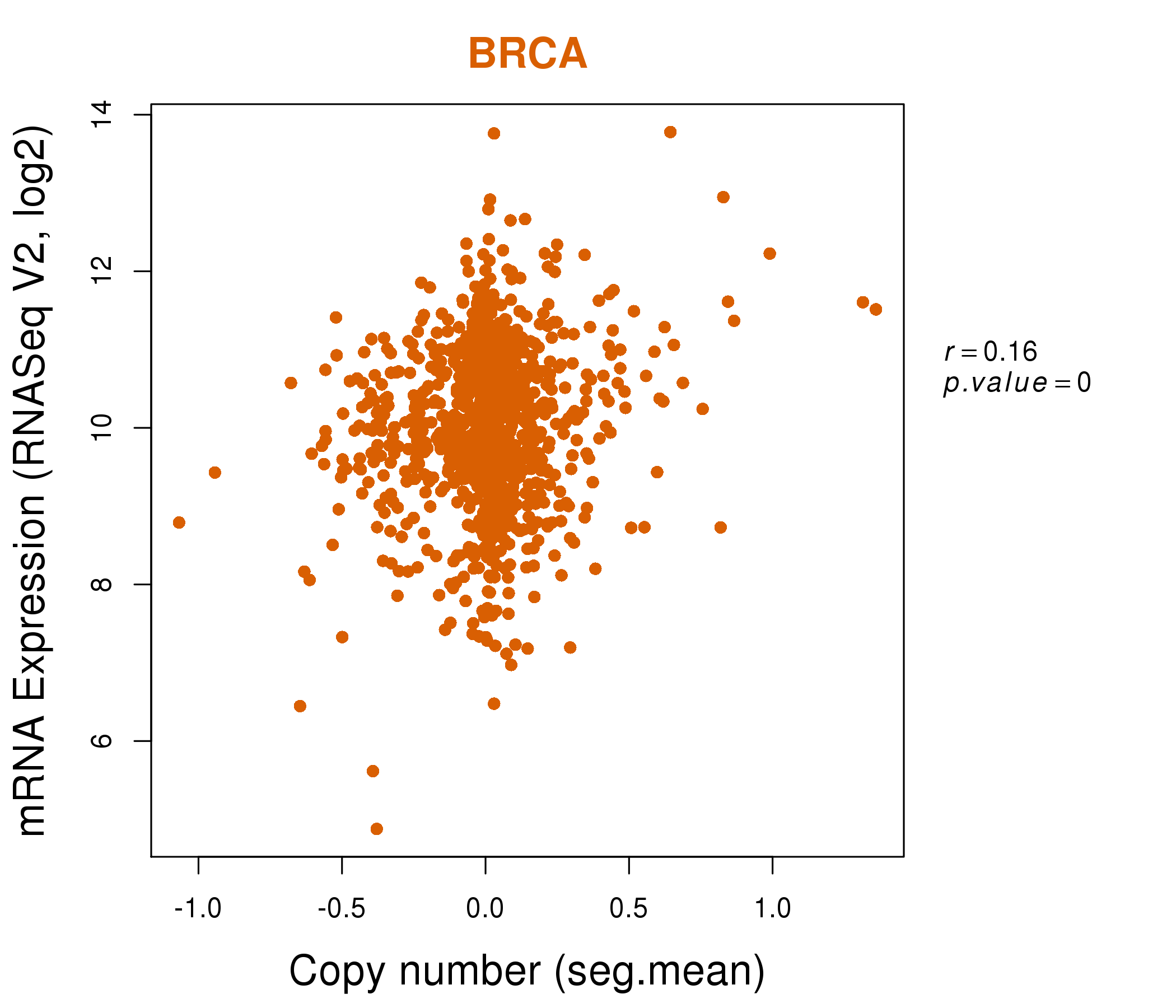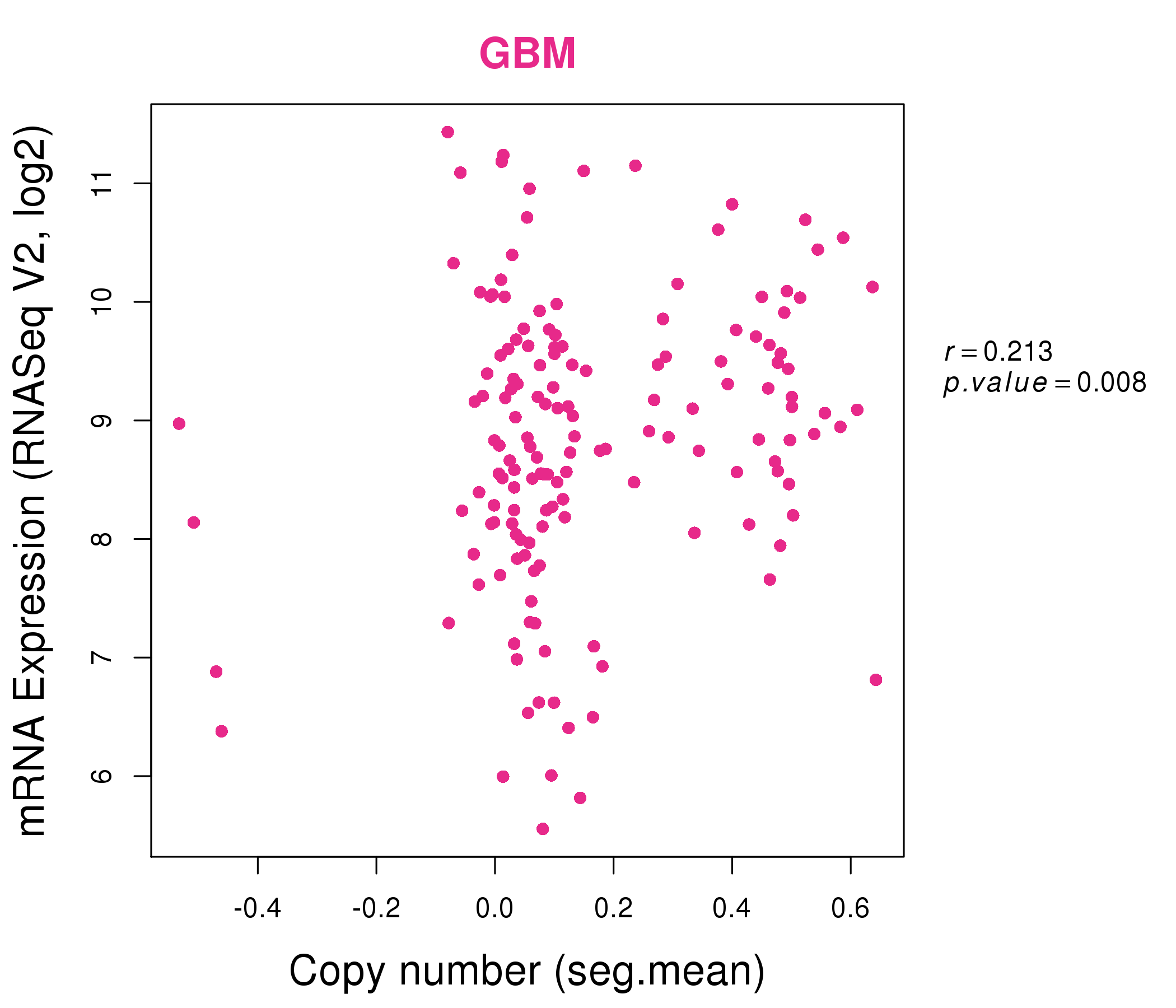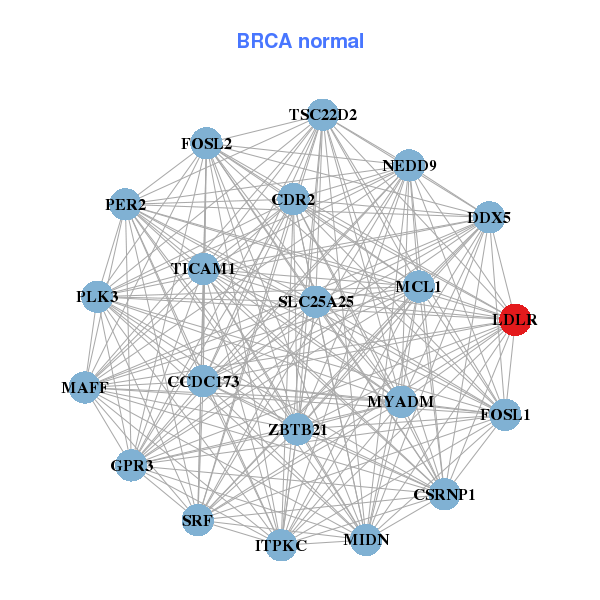|
|||||||||||||||||||||||||||||||||||||||||||||||||||||||||||||||||||||||||||||||||||||||||||||||||||||||||||||||||||||||||||||||||||||||||||||||||||||||||||||||||||||||||||||||||||||||||||||||||||||||||||||||||||||||||||||||||||||||||||||||||||||||||||||||||||||||||||||||||||||||||||||||||||||||||||||||||||||||||||||||||||||||||||||||||||||||||||||||||||||||||||||||||||||||||||||||||||||||||
| |
| Phenotypic Information (metabolism pathway, cancer, disease, phenome) |
| |
| |
| Gene-Gene Network Information: Co-Expression Network, Interacting Genes & KEGG |
| |
|
| Gene Summary for LDLR |
| Basic gene info. | Gene symbol | LDLR |
| Gene name | low density lipoprotein receptor | |
| Synonyms | FH|FHC|LDLCQ2 | |
| Cytomap | UCSC genome browser: 19p13.2 | |
| Genomic location | chr19 :11200037-11244505 | |
| Type of gene | protein-coding | |
| RefGenes | NM_000527.4, NM_001195798.1,NM_001195799.1,NM_001195800.1,NM_001195803.1, NM_001195802.1, | |
| Ensembl id | ENSG00000130164 | |
| Description | LDL receptorlow-density lipoprotein receptorlow-density lipoprotein receptor class A domain-containing protein 3 | |
| Modification date | 20141222 | |
| dbXrefs | MIM : 606945 | |
| HGNC : HGNC | ||
| Ensembl : ENSG00000130164 | ||
| HPRD : 06091 | ||
| Vega : OTTHUMG00000171935 | ||
| Protein | UniProt: P01130 go to UniProt's Cross Reference DB Table | |
| Expression | CleanEX: HS_LDLR | |
| BioGPS: 3949 | ||
| Gene Expression Atlas: ENSG00000130164 | ||
| The Human Protein Atlas: ENSG00000130164 | ||
| Pathway | NCI Pathway Interaction Database: LDLR | |
| KEGG: LDLR | ||
| REACTOME: LDLR | ||
| ConsensusPathDB | ||
| Pathway Commons: LDLR | ||
| Metabolism | MetaCyc: LDLR | |
| HUMANCyc: LDLR | ||
| Regulation | Ensembl's Regulation: ENSG00000130164 | |
| miRBase: chr19 :11,200,037-11,244,505 | ||
| TargetScan: NM_000527 | ||
| cisRED: ENSG00000130164 | ||
| Context | iHOP: LDLR | |
| cancer metabolism search in PubMed: LDLR | ||
| UCL Cancer Institute: LDLR | ||
| Assigned class in ccmGDB | A - This gene has a literature evidence and it belongs to cancer gene. | |
| References showing role of LDLR in cancer cell metabolism | 1. Nagiec MM, Skepner AP, Negri J, Eichhorn M, Kuperwasser N, et al. (2015) Modulators of hepatic lipoprotein metabolism identified in a search for small-molecule inducers of tribbles pseudokinase 1 expression. PLoS One 10: e0120295. doi: 10.1371/journal.pone.0120295. pmid: 4374785. go to article 2. Bissig-Choisat B, Wang L, Legras X, Saha PK, Chen L, et al. (2015) Development and rescue of human familial hypercholesterolaemia in a xenograft mouse model. Nat Commun 6: 7339. doi: 10.1038/ncomms8339. go to article 3. Guillaumond F, Bidaut G, Ouaissi M, Servais S, Gouirand V, et al. (2015) Cholesterol uptake disruption, in association with chemotherapy, is a promising combined metabolic therapy for pancreatic adenocarcinoma. Proc Natl Acad Sci U S A 112: 2473-2478. doi: 10.1073/pnas.1421601112. pmid: 4345573. go to article 4. Rios-Marco P, Martin-Fernandez M, Soria-Bretones I, Rios A, Carrasco MP, et al. (2013) Alkylphospholipids deregulate cholesterol metabolism and induce cell-cycle arrest and autophagy in U-87 MG glioblastoma cells. Biochim Biophys Acta 1831: 1322-1334. doi: 10.1016/j.bbalip.2013.05.004. go to article 5. Daker M, Bhuvanendran S, Ahmad M, Takada K, Khoo AS (2013) Deregulation of lipid metabolism pathway genes in nasopharyngeal carcinoma cells. Mol Med Rep 7: 731-741. doi: 10.3892/mmr.2012.1253. pmid: 3597460. go to article | |
| Top |
| Phenotypic Information for LDLR(metabolism pathway, cancer, disease, phenome) |
| Cancer | CGAP: LDLR |
| Familial Cancer Database: LDLR | |
| * This gene is included in those cancer gene databases. |
|
|
|
|
|
| . | |||||||||||||||||||||||||||||||||||||||||||||||||||||||||||||||||||||||||||||||||||||||||||||||||||||||||||||||||||||||||||||||||||||||||||||||||||||||||||||||||||||||||||||||||||||||||||||||||||||||||||||||||||||||||||||||||||||||||||||||||||||||||||||||||||||||||||||||||||||||||||||||||||||||||||||||||||||||||||||||||||||||||||||||||||||||||||||||||||||||||||||||||||||||||||||||||||
Oncogene 1 | Significant driver gene in | ||||||||||||||||||||||||||||||||||||||||||||||||||||||||||||||||||||||||||||||||||||||||||||||||||||||||||||||||||||||||||||||||||||||||||||||||||||||||||||||||||||||||||||||||||||||||||||||||||||||||||||||||||||||||||||||||||||||||||||||||||||||||||||||||||||||||||||||||||||||||||||||||||||||||||||||||||||||||||||||||||||||||||||||||||||||||||||||||||||||||||||||||||||||||||||||||||||||||
| cf) number; DB name 1 Oncogene; http://nar.oxfordjournals.org/content/35/suppl_1/D721.long, 2 Tumor Suppressor gene; https://bioinfo.uth.edu/TSGene/, 3 Cancer Gene Census; http://www.nature.com/nrc/journal/v4/n3/abs/nrc1299.html, 4 CancerGenes; http://nar.oxfordjournals.org/content/35/suppl_1/D721.long, 5 Network of Cancer Gene; http://ncg.kcl.ac.uk/index.php, 1Therapeutic Vulnerabilities in Cancer; http://cbio.mskcc.org/cancergenomics/statius/ |
| REACTOME_METABOLISM_OF_LIPIDS_AND_LIPOPROTEINS REACTOME_LIPOPROTEIN_METABOLISM | |
| OMIM | 143890; phenotype. 143890; phenotype. 606945; gene. 606945; gene. |
| Orphanet | 391665; Homozygous familial hypercholesterolemia. 391665; Homozygous familial hypercholesterolemia. 406; Heterozygous familial hypercholesterolemia. 406; Heterozygous familial hypercholesterolemia. |
| Disease | KEGG Disease: LDLR |
| MedGen: LDLR (Human Medical Genetics with Condition) | |
| ClinVar: LDLR | |
| Phenotype | MGI: LDLR (International Mouse Phenotyping Consortium) |
| PhenomicDB: LDLR | |
| Mutations for LDLR |
| * Under tables are showing count per each tissue to give us broad intuition about tissue specific mutation patterns.You can go to the detailed page for each mutation database's web site. |
| - Statistics for Tissue and Mutation type | Top |
 |
| - For Inter-chromosomal Variations |
| There's no inter-chromosomal structural variation. |
| - For Intra-chromosomal Variations |
| * Intra-chromosomal variantions includes 'intrachromosomal amplicon to amplicon', 'intrachromosomal amplicon to non-amplified dna', 'intrachromosomal deletion', 'intrachromosomal fold-back inversion', 'intrachromosomal inversion', 'intrachromosomal tandem duplication', 'Intrachromosomal unknown type', 'intrachromosomal with inverted orientation', 'intrachromosomal with non-inverted orientation'. |
 |
| Sample | Symbol_a | Chr_a | Start_a | End_a | Symbol_b | Chr_b | Start_b | End_b |
| ovary | LDLR | chr19 | 11204952 | 11204972 | GATAD2A | chr19 | 19537511 | 19537531 |
| pancreas | LDLR | chr19 | 11229432 | 11229452 | LDLR | chr19 | 11212426 | 11212446 |
| cf) Tissue number; Tissue name (1;Breast, 2;Central_nervous_system, 3;Haematopoietic_and_lymphoid_tissue, 4;Large_intestine, 5;Liver, 6;Lung, 7;Ovary, 8;Pancreas, 9;Prostate, 10;Skin, 11;Soft_tissue, 12;Upper_aerodigestive_tract) |
| * From mRNA Sanger sequences, Chitars2.0 arranged chimeric transcripts. This table shows LDLR related fusion information. |
| ID | Head Gene | Tail Gene | Accession | Gene_a | qStart_a | qEnd_a | Chromosome_a | tStart_a | tEnd_a | Gene_a | qStart_a | qEnd_a | Chromosome_a | tStart_a | tEnd_a |
| BU631838 | EXOSC6 | 19 | 181 | 16 | 70284134 | 70284296 | LDLR | 176 | 688 | 19 | 11241959 | 11243622 | |
| AA002171 | LDLR | 1 | 183 | 19 | 11244309 | 11244491 | ABAT | 184 | 493 | 16 | 8877665 | 8877972 | |
| BF753479 | LDLR | 6 | 111 | 19 | 11237475 | 11237581 | ANKRD11 | 103 | 190 | 16 | 89481292 | 89481379 | |
| Top |
| Mutation type/ Tissue ID | brca | cns | cerv | endome | haematopo | kidn | Lintest | liver | lung | ns | ovary | pancre | prost | skin | stoma | thyro | urina | |||
| Total # sample | 1 | 2 | 2 | |||||||||||||||||
| GAIN (# sample) | 1 | 2 | 2 | |||||||||||||||||
| LOSS (# sample) |
| cf) Tissue ID; Tissue type (1; Breast, 2; Central_nervous_system, 3; Cervix, 4; Endometrium, 5; Haematopoietic_and_lymphoid_tissue, 6; Kidney, 7; Large_intestine, 8; Liver, 9; Lung, 10; NS, 11; Ovary, 12; Pancreas, 13; Prostate, 14; Skin, 15; Stomach, 16; Thyroid, 17; Urinary_tract) |
| Top |
|
 |
| Top |
| Stat. for Non-Synonymous SNVs (# total SNVs=63) | (# total SNVs=19) |
 | 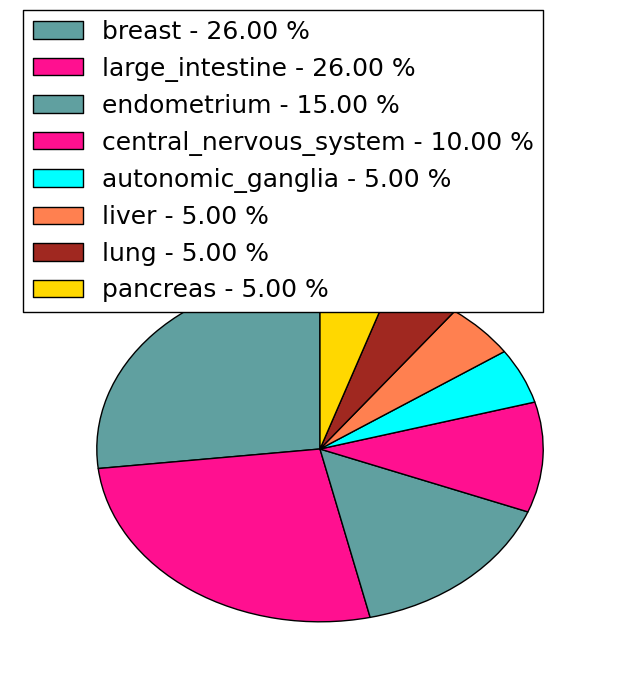 |
(# total SNVs=3) | (# total SNVs=1) |
 |  |
| Top |
| * When you move the cursor on each content, you can see more deailed mutation information on the Tooltip. Those are primary_site,primary_histology,mutation(aa),pubmedID. |
| GRCh37 position | Mutation(aa) | Unique sampleID count |
| chr19:11224014-11224014 | p.R416Q | 3 |
| chr19:11218140-11218140 | p.N297S | 3 |
| chr19:11224354-11224354 | p.A501V | 2 |
| chr19:11240220-11240220 | p.F807F | 2 |
| chr19:11210922-11210922 | p.E31K | 2 |
| chr19:11231084-11231085 | p.G676fs*40 | 2 |
| chr19:11215910-11215910 | p.S110P | 2 |
| chr19:11215918-11215918 | p.D112E | 2 |
| chr19:11227680-11227680 | p.? | 2 |
| chr19:11230789-11230789 | p.I623V | 2 |
| Top |
|
 |
| Point Mutation/ Tissue ID | 1 | 2 | 3 | 4 | 5 | 6 | 7 | 8 | 9 | 10 | 11 | 12 | 13 | 14 | 15 | 16 | 17 | 18 | 19 | 20 |
| # sample | 1 | 3 | 14 | 5 | 4 | 2 | 1 | 6 | 4 | 5 | 1 | 17 | 9 | 6 | ||||||
| # mutation | 1 | 3 | 14 | 5 | 4 | 2 | 1 | 6 | 4 | 5 | 1 | 24 | 9 | 7 | ||||||
| nonsynonymous SNV | 1 | 1 | 9 | 3 | 3 | 1 | 1 | 5 | 4 | 5 | 1 | 15 | 5 | 4 | ||||||
| synonymous SNV | 2 | 5 | 2 | 1 | 1 | 1 | 9 | 4 | 3 |
| cf) Tissue ID; Tissue type (1; BLCA[Bladder Urothelial Carcinoma], 2; BRCA[Breast invasive carcinoma], 3; CESC[Cervical squamous cell carcinoma and endocervical adenocarcinoma], 4; COAD[Colon adenocarcinoma], 5; GBM[Glioblastoma multiforme], 6; Glioma Low Grade, 7; HNSC[Head and Neck squamous cell carcinoma], 8; KICH[Kidney Chromophobe], 9; KIRC[Kidney renal clear cell carcinoma], 10; KIRP[Kidney renal papillary cell carcinoma], 11; LAML[Acute Myeloid Leukemia], 12; LUAD[Lung adenocarcinoma], 13; LUSC[Lung squamous cell carcinoma], 14; OV[Ovarian serous cystadenocarcinoma ], 15; PAAD[Pancreatic adenocarcinoma], 16; PRAD[Prostate adenocarcinoma], 17; SKCM[Skin Cutaneous Melanoma], 18:STAD[Stomach adenocarcinoma], 19:THCA[Thyroid carcinoma], 20:UCEC[Uterine Corpus Endometrial Carcinoma]) |
| Top |
| * We represented just top 10 SNVs. When you move the cursor on each content, you can see more deailed mutation information on the Tooltip. Those are primary_site, primary_histology, mutation(aa), pubmedID. |
| Genomic Position | Mutation(aa) | Unique sampleID count |
| chr19:11218140 | p.N129S,LDLR | 3 |
| chr19:11210922 | p.E31K,LDLR | 2 |
| chr19:11224428 | p.P358S,LDLR | 2 |
| chr19:11224014 | p.R248Q,LDLR | 2 |
| chr19:11238760 | p.S295C,LDLR | 1 |
| chr19:11215934 | p.S480P,LDLR | 1 |
| chr19:11224056 | p.P680L,LDLR | 1 |
| chr19:11216251 | p.D98H,LDLR | 1 |
| chr19:11224398 | p.Y297Y,LDLR | 1 |
| chr19:11231068 | p.E482V,LDLR | 1 |
| * Copy number data were extracted from TCGA using R package TCGA-Assembler. The URLs of all public data files on TCGA DCC data server were gathered on Jan-05-2015. Function ProcessCNAData in TCGA-Assembler package was used to obtain gene-level copy number value which is calculated as the average copy number of the genomic region of a gene. |
 |
| cf) Tissue ID[Tissue type]: BLCA[Bladder Urothelial Carcinoma], BRCA[Breast invasive carcinoma], CESC[Cervical squamous cell carcinoma and endocervical adenocarcinoma], COAD[Colon adenocarcinoma], GBM[Glioblastoma multiforme], Glioma Low Grade, HNSC[Head and Neck squamous cell carcinoma], KICH[Kidney Chromophobe], KIRC[Kidney renal clear cell carcinoma], KIRP[Kidney renal papillary cell carcinoma], LAML[Acute Myeloid Leukemia], LUAD[Lung adenocarcinoma], LUSC[Lung squamous cell carcinoma], OV[Ovarian serous cystadenocarcinoma ], PAAD[Pancreatic adenocarcinoma], PRAD[Prostate adenocarcinoma], SKCM[Skin Cutaneous Melanoma], STAD[Stomach adenocarcinoma], THCA[Thyroid carcinoma], UCEC[Uterine Corpus Endometrial Carcinoma] |
| Top |
| Gene Expression for LDLR |
| * CCLE gene expression data were extracted from CCLE_Expression_Entrez_2012-10-18.res: Gene-centric RMA-normalized mRNA expression data. |
 |
| * Normalized gene expression data of RNASeqV2 was extracted from TCGA using R package TCGA-Assembler. The URLs of all public data files on TCGA DCC data server were gathered at Jan-05-2015. Only eight cancer types have enough normal control samples for differential expression analysis. (t test, adjusted p<0.05 (using Benjamini-Hochberg FDR)) |
 |
| Top |
| * This plots show the correlation between CNV and gene expression. |
: Open all plots for all cancer types
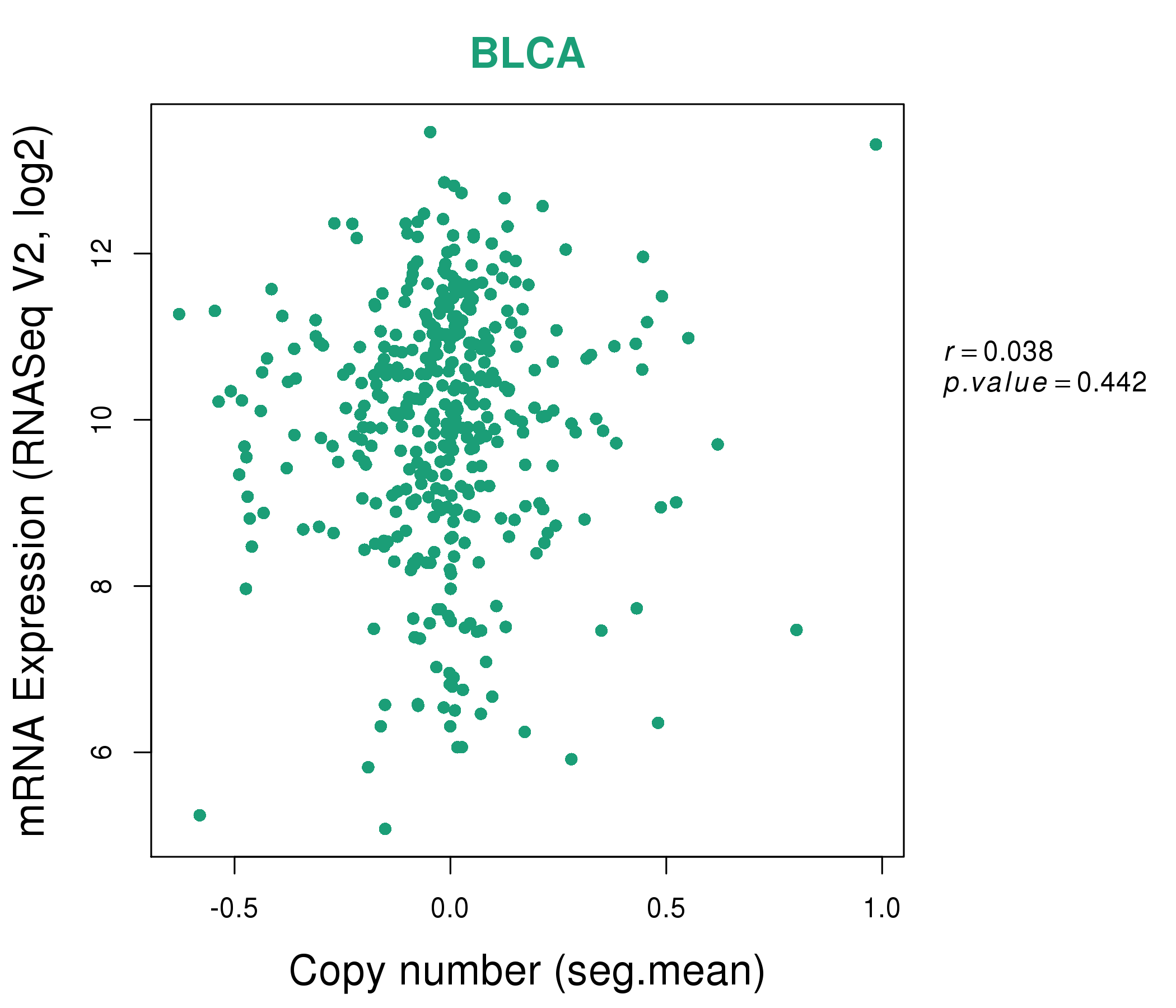 |
|
 |
|
| Top |
| Gene-Gene Network Information |
| * Co-Expression network figures were drawn using R package igraph. Only the top 20 genes with the highest correlations were shown. Red circle: input gene, orange circle: cell metabolism gene, sky circle: other gene |
: Open all plots for all cancer types
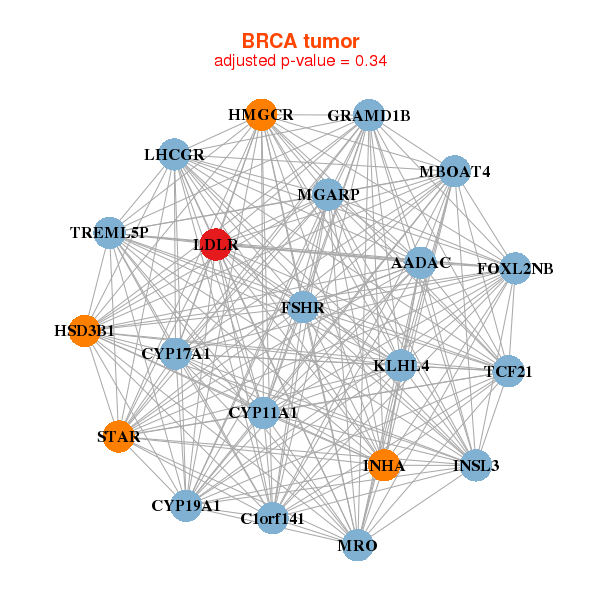 |
| ||||
| AKR1A1,ATPIF1,CNKSR1,CTDSP1,MTFR1L,FAM73B,GPATCH3, GPN2,JMJD7-PLA2G4B,LDLRAP1,LYPLA2,LYPLA2P1,PEX14,PINK1, PQLC2,SEPN1,SYF2,TMEM222,TRAPPC12,ZBTB17,ZNF296 | APEX2,ARFIP2,C10orf35,SYNE4,CACFD1,CADM4,CLN3, DAK,DGCR2,DNAL4,ISYNA1,ITGA3,LDLRAP1,LPAR2, LSR,PAK4,PRKCZ,PRPF19,PRRG2,RAB17,SPINT2 | ||||
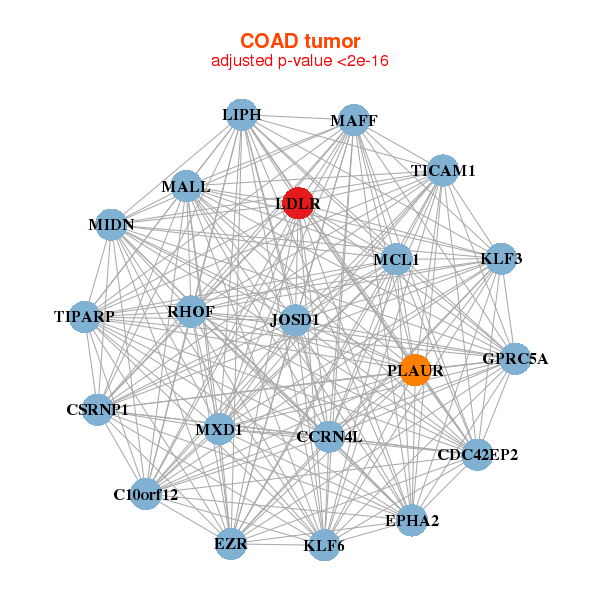 |
| ||||
| ARHGEF10L,ATP13A2,KDF1,STPG1,CASP9,CASZ1,CLSTN1, DHDDS,DNAJC16,FUCA1,GALE,KIAA1522,LDLRAP1,LYPLA2, NBL1,PAFAH2,PQLC2,RPS6KA1,SLC44A4,TMEM57,TRIOBP | BDH1,CCNJL,CDX2,CPT2,DTX4,FUK,GOLPH3L, IHH,LDLRAP1,LGALS4,MB,NADK,SFXN5,SHD, SPR,STAP2,TRAF3IP2,TST,VAV3,WDR78,ZBTB7C |
| * Co-Expression network figures were drawn using R package igraph. Only the top 20 genes with the highest correlations were shown. Red circle: input gene, orange circle: cell metabolism gene, sky circle: other gene |
: Open all plots for all cancer types
| Top |
: Open all interacting genes' information including KEGG pathway for all interacting genes from DAVID
| Top |
| Pharmacological Information for LDLR |
| DB Category | DB Name | DB's ID and Url link |
| Chemistry | BindingDB | P01130; -. |
| Chemistry | ChEMBL | CHEMBL3311; -. |
| Chemistry | BindingDB | P01130; -. |
| Chemistry | ChEMBL | CHEMBL3311; -. |
| Organism-specific databases | PharmGKB | PA227; -. |
| Organism-specific databases | PharmGKB | PA227; -. |
| Organism-specific databases | CTD | 3949; -. |
| Organism-specific databases | CTD | 3949; -. |
| * Gene Centered Interaction Network. |
 |
| * Drug Centered Interaction Network. |
| DrugBank ID | Target Name | Drug Groups | Generic Name | Drug Centered Network | Drug Structure |
| DB00707 | low density lipoprotein receptor | approved; investigational | Porfimer | 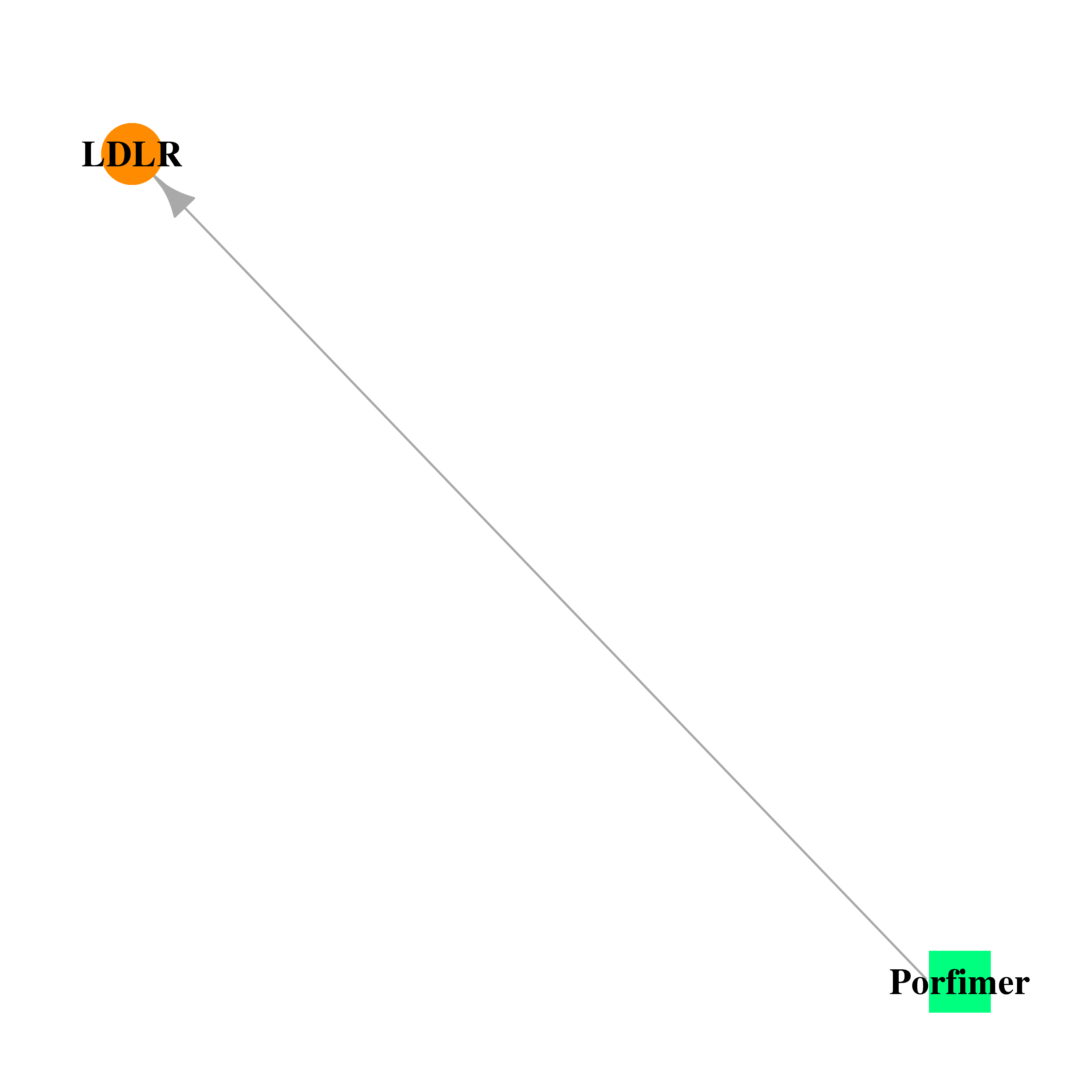 |  |
| DB02944 | low density lipoprotein receptor | experimental | Alpha-D-Mannose |  |  |
| DB01095 | low density lipoprotein receptor | approved | Fluvastatin |  |  |
| DB00335 | low density lipoprotein receptor | approved | Atenolol | 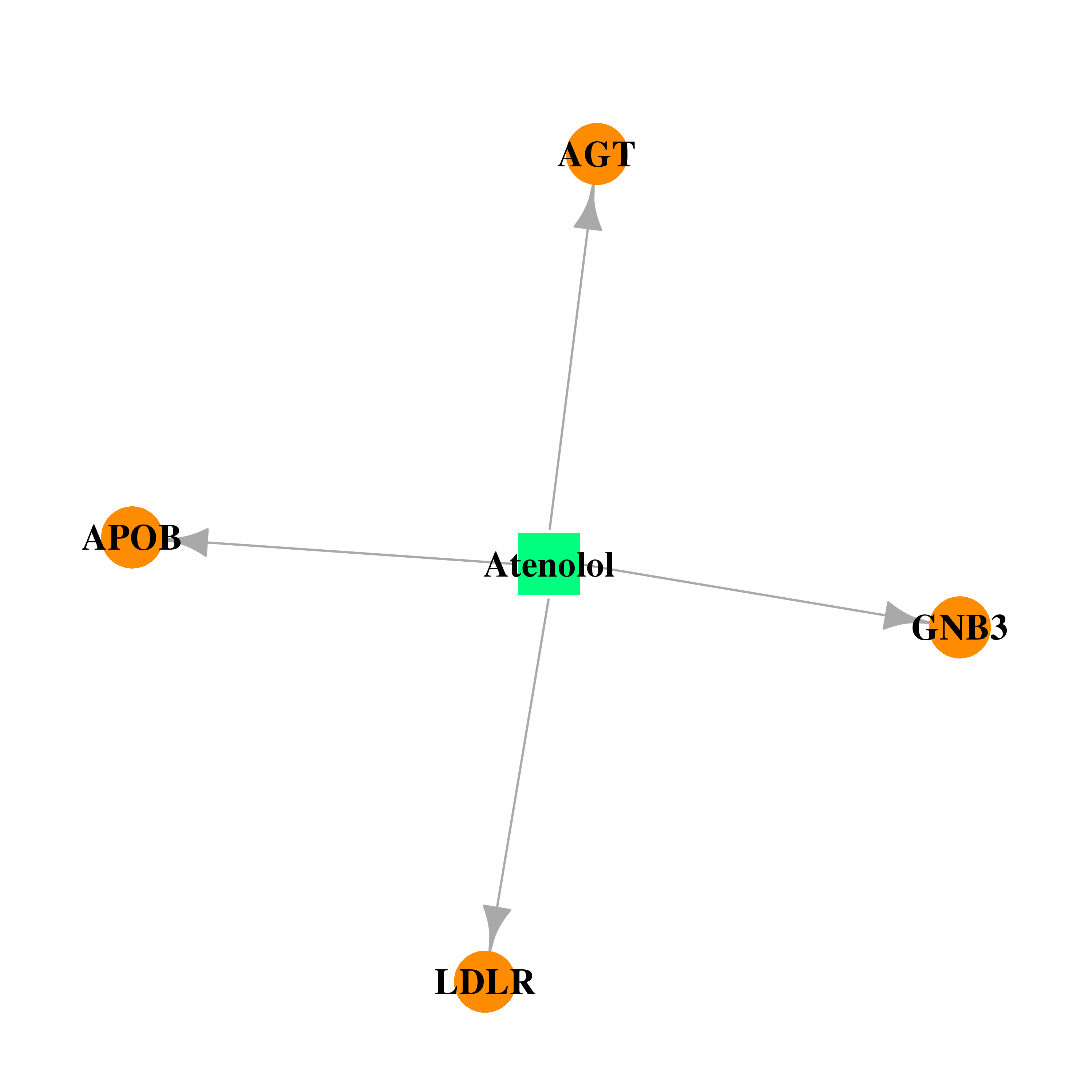 |  |
| DB01029 | low density lipoprotein receptor | approved; investigational | Irbesartan | 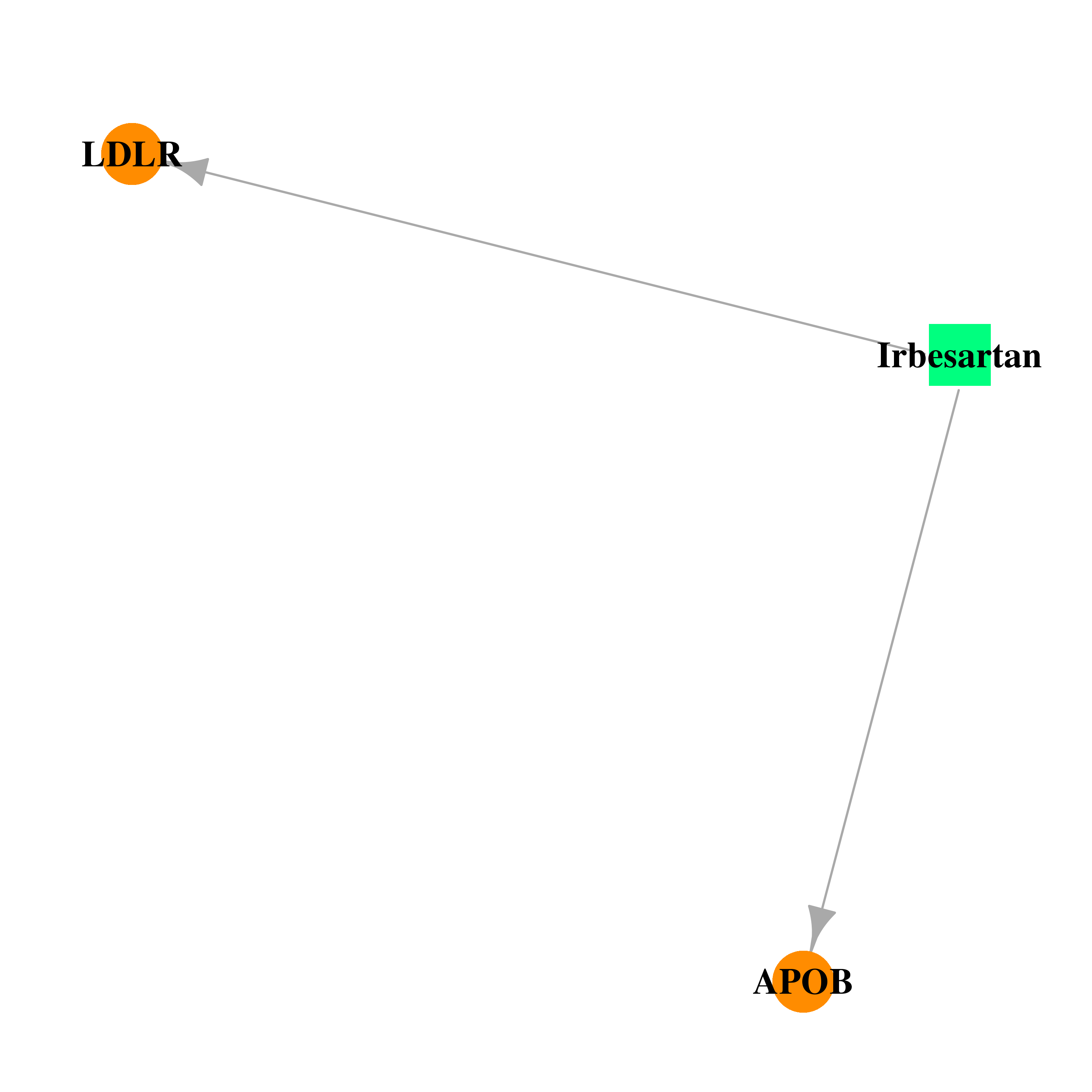 |  |
| DB01076 | low density lipoprotein receptor | approved | Atorvastatin | 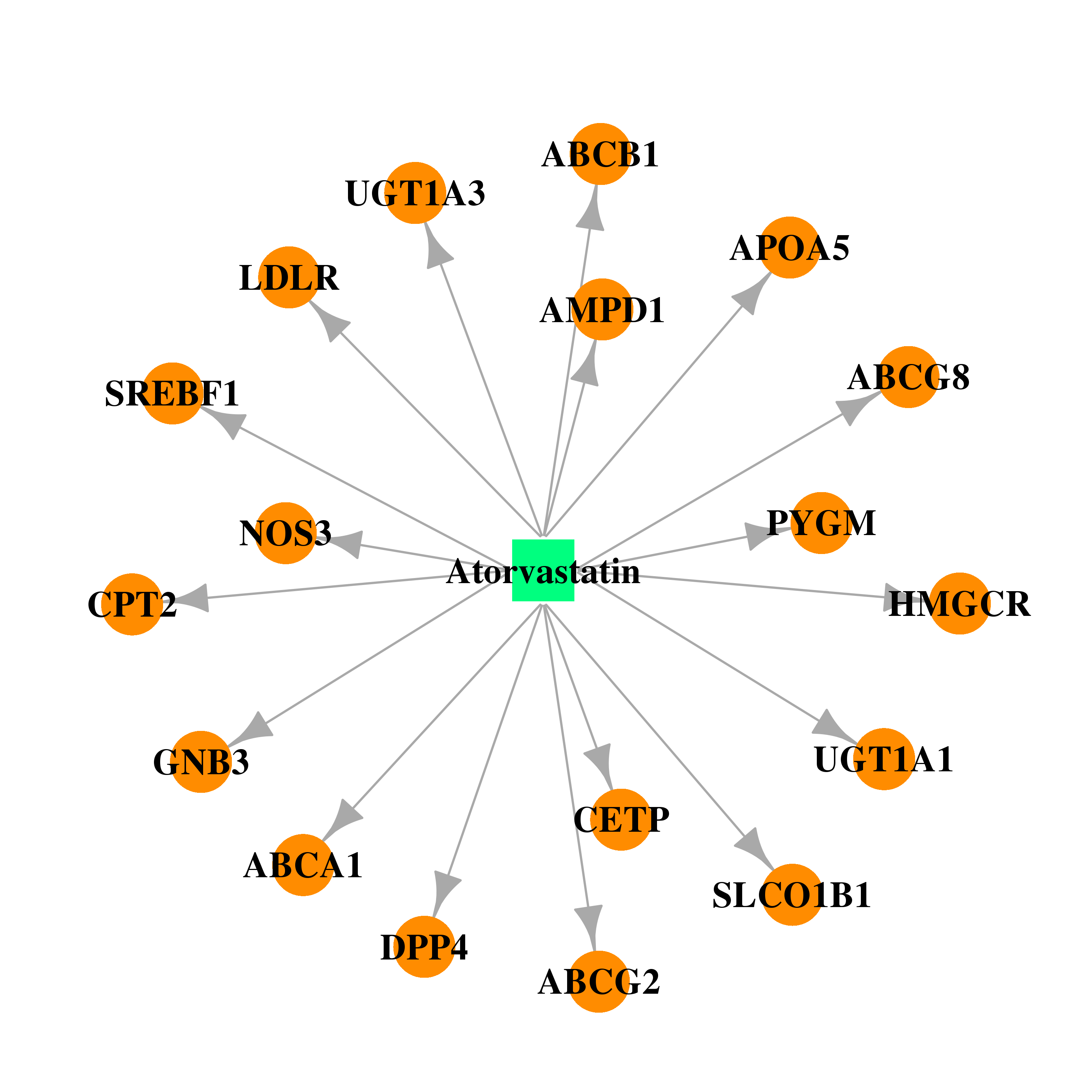 | 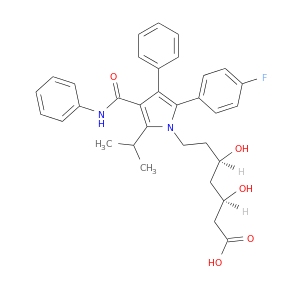 |
| DB00264 | low density lipoprotein receptor | approved; investigational | Metoprolol |  |  |
| Top |
| Cross referenced IDs for LDLR |
| * We obtained these cross-references from Uniprot database. It covers 150 different DBs, 18 categories. http://www.uniprot.org/help/cross_references_section |
: Open all cross reference information
|
Copyright © 2016-Present - The Univsersity of Texas Health Science Center at Houston @ |






